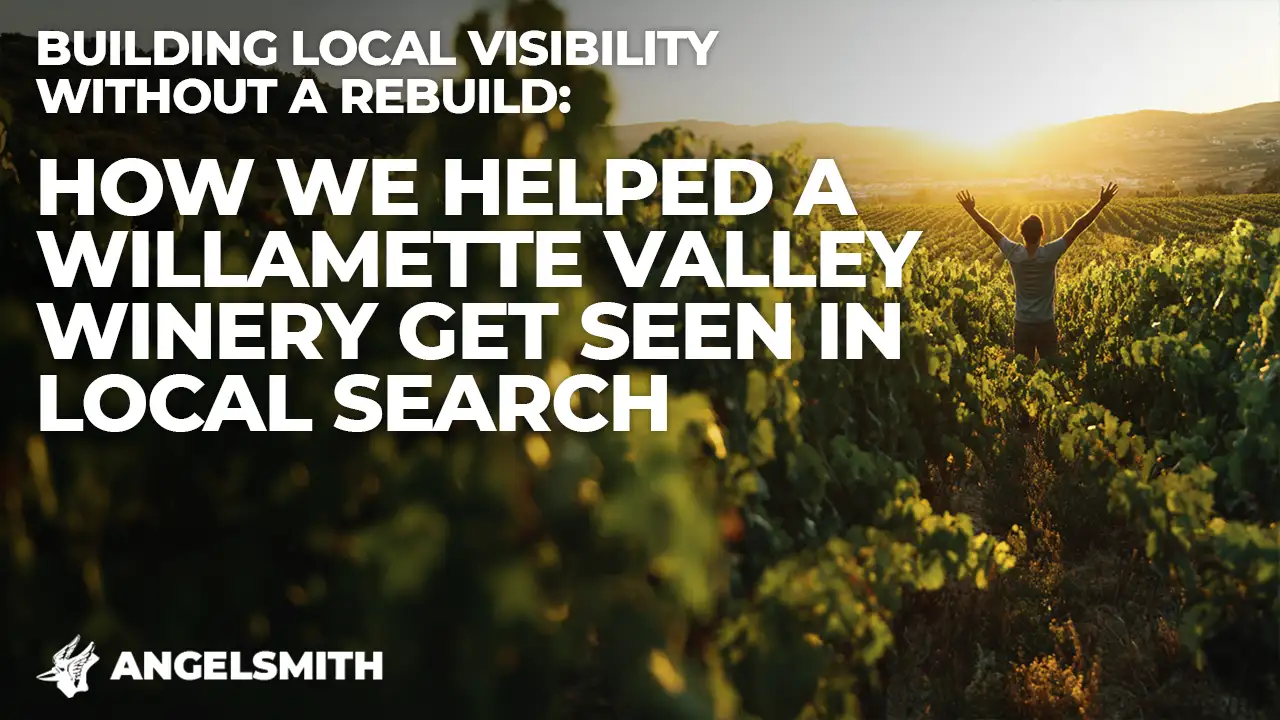
Building Local Visibility Without a Rebuild:
How We Helped a Willamette Valley Winery Get Seen In Local Search
In the heart of Oregon’s ultra-competitive Willamette Valley wine region, one winery was quietly getting buried—digitally speaking.
Despite producing beautiful wines and offering a top-tier tasting room experience, they were virtually invisible on Google’s local map results. And with tasting room visits tied directly to local search visibility, this wasn’t just an SEO problem—it was a revenue problem.
The Expansion Challenge
This wasn’t a winery with nothing in place. They had a solid brand, a loyal following, and a team in the middle of a full website redesign. But their local rankings were another story.
When we began our work, a BrightLocal scan of their Google Business Profile showed a near-complete absence from the Map Pack. Across a 49 square mile grid centered on their location, they were ranking 20th or worse—if they appeared at all.
And this wasn’t some sleepy corner of the country. This winery operates in the most saturated wine region in Oregon. Dozens of competitors—with large budgets and well-aged domain authority—were crowding them out of search.
Their mission to us was simple:
Architect a strategy to improve local rankings and drive more traffic to the tasting room.
But they made one thing clear—don’t touch the visible website. They were mid-redesign, and didn’t want to double up efforts.
The Expansion Blueprint
Rather than pushing a traditional content-heavy local SEO campaign, we rolled out a focused, infrastructure-first approach rooted in our Expansion Architecture methodology.
On-Site SEO: Light Touch, High Impact
Using Google Search Console, we identified and excluded several duplicate and irrelevant pages that were clouding the site’s topical clarity. We also fine-tuned a handful of page titles to better reflect their geographic relevance.
But again—this wasn’t a content overhaul or design project. Our edits were surgical.
The Brand Authority Hub: Our Proprietary Foundation
The core of our strategy was building a Brand Authority Hub—a proprietary system of interconnected Web 2.0 properties, cloud stacks, and strategically placed backlinks. Think of it as a digital scaffold that amplifies brand relevance without requiring content calendars, blog posts, or social updates.
We focused on:
Establishing branded profiles across a wide Web 2.0 network (Blogger, Weebly, etc.)
Layering in cloud-based assets to enhance topical depth
Earning links from topically aligned, reputable sources
This approach allowed us to signal strong brand authority and relevance to Google, even without touching the client’s main website or content pipeline.
Standard Citations: Covered, Not Overplayed
We also executed a standard citation campaign to ensure consistent NAP data across major directories. It was a simple but necessary layer in the architecture—helpful for trust, but not the centerpiece of the strategy.
The Results: From 0% Visibility To 100% Visibility In Just 90 Days
In just three months, the winery’s local visibility skyrocketed.
Average Map Rank Improvement: From 20+ to 5.3
Geogrid Coverage: Once unranked over 96% of the local area, now 100% ranked, with 88% top 10 rankings and 25% top three rankings.
Ranking Footprint: They are now ranking in the top 3 positions for local queries across the majority of their service area.
Here’s the kicker:
We did this without a redesign, without new blog posts, and without any social media work.
This wasn’t a content play. It was a technical and strategic foundation, built quietly in the background, that enabled Google to better understand—and reward—the winery’s relevance.

The Real-World Impact
At the time of writing, tasting room traffic is up and reservation calendars are full. Because of the region’s natural seasonality, it’s too early to attribute specific numbers, but early signs are promising. We’ll revisit year-over-year data as the season progresses.
What This Means for Growth-Stage Brands
For wineries—and frankly, any local business—it’s tempting to think that visibility requires flashy content or social media hustle. But as this project shows, that’s not always the case.
Sometimes, what you need is a quiet partner with a blueprint, a taskforce, and the technical depth to build unseen structures that drive real-world results.
At Angelsmith, that’s what we do. Whether it’s for a winery in Oregon or a fitness franchisor expanding into new markets, our job is to build the digital infrastructure for growth—and let your brand shine from there.
Want More Actionable Advice?
Join the exclusive mastermind group for wine industry professionals, offering insider knowledge, personalized strategies, and real-time answers to elevate your marketing and MarTech game.